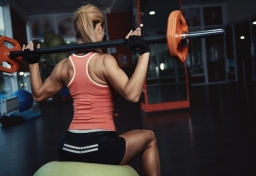Lift like a Girl – Weightlifting for Women
Wednesday, October 25, 2017 - 09:02

With the ever increasing popularity of Crossfit, obstacle course racing (Spartan, Warrior Dash and mud runs) and a few great marketing campaigns - check out #liftlikeagirl and This Girl Can - women are heading to their local gym and hitting the weight room more than ever before. Weightlifting is one of the best ways to increase metabolism, build bone density, reduce weight and blood pressure, as well as the added benefits of boosting your confidence and improving overall quality of life.
When people think of weightlifting, typically the first thing that comes to mind is male bodybuilders and dumbbells, when in fact bodybuilding and weightlifting are very different things. There are many ways to build body strength that include:
Powerlifting and Olympic Style Weightlifting - Both of these sports are similar in respect to competition with the goal of lifting as much weight as possible in several different lifts. The winner is determined by whoever has the highest combined total (which is adding up their numbers across all the lifts). The difference between these two methods of lifting weights is simply which lifts are performed. In powerlifting, you perform the squat, the bench press and the deadlift whereas in Olympic Style weightlifting, the athlete performs two lifts overhead known as the clean and jerk, and the snatch.
“Powerlifting is like life: It’s a progression of stages. You don’t always move forward, but if you keep going, eventually you will succeed.” - Linda Rousseau, age 63 from Hamilton, Ont., set a new world record for the M3 84-kilogram weight category at the North American Regional Powerlifting Championships on July 5, 2017.
Bodyweight or Calisthenics - The two great things about bodyweight training is that it doesn’t require any financial investment and the convenience of being able to do the exercises anywhere - home, work, or even on vacation. Typical exercises are push-ups, squats, lunges, pull ups, burpees, planks, and wall sits. Be as creative as you want and modify each movement to suit your particular needs.
Kettlebells, sandbags, clubbell, etc. - While relatively new to North America, kettlebells have been around for a long time. Made of iron and shaped like a cannonball with a handle on the top kettlebells offer full body conditioning, increased mobility and range of motion. With its wide appeal and accessibility, it’s easy to find kettlebell classes that offer group or individual training, depending on your preferences.
Proper Technique - If you are a beginner, it’s important to learn the correct movements when first starting out. Good form ensures that you get the most out of your efforts, too much and an injury can put a serious dent in your training, too little and you won’t see the results you’re looking for. The best idea is to shop around and find a gym that allows you to work with an athletic trainer that can teach you the basics.
The community surrounding weightlifting gyms are a large part of what keeps women coming back week after week. The social side and its support make the learning process a lot more fun, so check what your local community has on offer, grab a weight and get lifting.
Sources:
O'Connor P, Poudevigne M, Cress M, Moti R, Clapp I. Safety and Efficacy of Supervised Strength Training Adopted in Pregnancy. Journal of Physical Activity & Health. March 2011;8(3):309-320.
Patterson M, Umstattd Meyer M, Beville J. Potential Predictors of College Women Meeting Strength Training Recommendations: Application of the Integrated Behavioral Model. Journal of Physical Activity & Health. July 2015;12(7):998-1004.
PERRY C. 12-Week Beginner's Weightlifting Plan for Women. Muscle & Fitness Hers. January 2017;18(1):94-103d.
Seguin R, Economos C, Palombo R, Hyatt R, Kuder J, Nelson M. Strength Training and Older Women: A Cross-Sectional Study Examining Factors Related to Exercise Adherence. Journal of Aging & Physical Activity. April 2010;18(2):201-218.
About the Author: Michelle is an information management specialist with many years focusing on sport and fitness research and education. Michelle has been sharing her expertise with SIRC for over 4 years.